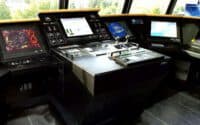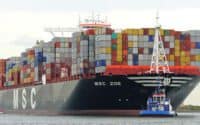Top 10 Innovations Revolutionizing the Cargo Shipping Industry

In an age where globalization surges forward and technological advancements accelerate at an unprecedented rate, the cargo shipping industry finds itself at the nexus of change. The vessels that once merely traversed our vast oceans carrying goods now embody the frontier of innovation, embracing a new era of efficiency and adaptability. From groundbreaking cold chain solutions that ensure our food remains fresh, to the marvel of 3D printing spare parts in the heart of the sea, the realm of cargo shipping is undergoing a transformative evolution. Let’s take a look now at the Top 10 Innovations Revolutionizing the Cargo Shipping Industry.
* Please send feedback/suggestions to editor @ shipuniverse.com
1. Autonomous Shipping
The dream of a self-navigating vessel is no longer the stuff of science fiction. Several key advancements are driving this shift:
- AI Navigation Systems: Advanced AI algorithms analyze vast amounts of data to make split-second navigation decisions. These systems can predict weather patterns, identify obstacles, and even make route adjustments for optimal fuel efficiency.
- Advanced Sensors and Lidar: Modern ships are equipped with a myriad of sensors. Lidar (Light Detection and Ranging) systems, for instance, use laser pulses to map surroundings in high resolution, allowing the ship to “see” its environment in real-time.
- Remote Operation Centers: Even as ships become more autonomous, human oversight remains crucial. Remote operation centers can monitor multiple ships simultaneously, providing a layer of human judgment when needed. Operators can take control in complex maneuvers or emergencies.
- Safety and Regulatory Challenges: While the technology is advancing rapidly, regulations need to keep pace. International maritime bodies are developing frameworks to ensure the safe operation of autonomous vessels.
2. Sustainable Propulsion
As the world grapples with climate change, the cargo shipping industry is under pressure to reduce its carbon footprint. Innovations in propulsion are leading the way:
- Wind Propulsion: Modern shipping is revisiting an age-old technology: sails. Rotor sails, for instance, use the Magnus effect to provide auxiliary thrust, reducing fuel consumption. Traditional-looking sails made of durable materials are also being tested on cargo vessels.
- Biofuels and Alternative Fuels: Biofuels derived from organic materials can be a drop-in replacement for traditional fuels, offering a greener alternative. Liquefied natural gas (LNG) is another cleaner fuel gaining traction in the industry.
- Hybrid and Electric Systems: Just as with cars, hybrid propulsion systems are entering the shipping world. These systems can switch between traditional fuels and electric power. Fully electric cargo vessels, while still in their infancy, are being piloted for shorter routes.
- Energy Recovery Systems: Technologies like turbochargers or waste heat recovery systems capture and reuse energy that would otherwise be lost, enhancing fuel efficiency.
3. Smart Containers
The humble shipping container is getting a tech upgrade, ensuring cargo is not just transported but also monitored and managed efficiently:
- Real-time Tracking: GPS and other tracking technologies allow companies and customers to know the exact location of their cargo at any given time, reducing uncertainties and improving logistics planning.
- Condition Monitoring: Sensors within containers can monitor conditions like temperature, humidity, and even shock. This is crucial for goods like pharmaceuticals or perishables that need specific conditions maintained.
- Auto-sealing Mechanisms: Security is a perennial concern in shipping. Modern containers come equipped with automated sealing mechanisms that can alert remote operators if tampered with.
- Integration with IoT: With the rise of the Internet of Things, containers can “communicate” with each other and with the ship’s central system, adjusting conditions inside if needed or alerting crew members to potential issues.
4. Advanced Port Automation
Efficient port operations are a linchpin in global trade. With rising cargo traffic, automation is becoming indispensable for ensuring rapid, safe, and efficient turnover:
- Robotic Systems: Automated robots are now commonly used for tasks like container stacking and unstacking. These robots can operate continuously with high precision, greatly reducing turnaround time.
- AI-Driven Cranes: Traditional cranes are being upgraded with AI algorithms, allowing them to autonomously pick up and set down containers, recognizing container sizes and optimizing stacking patterns.
- Automated Guided Vehicles (AGVs): These driverless vehicles transport containers within the port premises. Using a combination of sensors, GPS, and AI, AGVs can swiftly move containers from ships to storage areas or vice versa without human intervention.
- Automated Gate Systems: Ports have started using automated gate systems that can scan and process trucks and their cargo without manual checks, speeding up entry and exit processes.
5. Blockchain in Logistics
Blockchain is revolutionizing logistics by offering a decentralized, transparent, and tamper-proof system:
- Streamlined Operations: Every entity in the shipping process, from suppliers to freight forwarders to end customers, can access a single, immutable version of transaction records. This reduces discrepancies and speeds up processing.
- Reduced Paperwork: Documentation like bills of lading can be digitized and stored on the blockchain. This not only reduces paperwork but also ensures that documents are instantly available to all stakeholders.
- Enhanced Transparency: Every step in the shipping process can be logged on the blockchain, providing unparalleled traceability. This can help resolve disputes, reduce fraud, and build trust among parties.
- Smart Contracts: These are self-executing contracts with the agreement directly written into lines of code. In logistics, they can automatically trigger payments or actions when certain conditions are met, eliminating delays.
6. IoT and Fleet Management
The Internet of Things (IoT) is linking the digital and physical worlds in ways that were previously unthinkable:
- Real-time Monitoring: Sensors placed on ships can provide continuous data on everything from fuel levels to engine performance. This allows fleet managers to have a real-time view of every ship’s status.
- Predictive Maintenance: By analyzing data from sensors, AI algorithms can predict when a part might fail or require maintenance. This helps reduce unexpected downtimes and extends the life of equipment.
- Optimized Routing: Using data from weather sensors, GPS, and traffic systems, routes can be continuously optimized for speed, safety, and fuel efficiency.
- Energy Management: IoT devices can monitor and adjust energy consumption on ships, ensuring optimal usage and reducing costs.
7. Cold Chain Innovations
Ensuring perishables retain their freshness throughout their journey is a critical challenge, and the cold chain is evolving to address this:
- Advanced Refrigeration Technologies: Modern refrigeration units use variable speed compressors and eco-friendly refrigerants that provide precise temperature control, optimizing energy consumption and reducing environmental impact.
- Real-time Monitoring: Integrated IoT sensors continuously monitor temperature, humidity, and other environmental parameters. If conditions deviate from the optimal range, automated systems can make adjustments or alert the crew.
- Insulated Container Designs: Enhanced insulation materials and construction techniques ensure that containers have better thermal performance, reducing energy demands and maintaining temperature stability.
- Data-Driven Logistics: Advanced analytics can predict potential disruptions in the cold chain, helping logistics providers preemptively address issues before they compromise cargo quality.
8. 3D Printing at Sea
The advent of onboard 3D printing is transforming ship maintenance and logistics:
- On-demand Production: Ships equipped with 3D printers can produce a range of spare parts as needed, eliminating the need to store vast inventories or wait for deliveries from ports.
- Material Advancements: Developments in printing materials, including metals and advanced polymers, ensure that printed parts are durable and meet operational requirements.
- Cost and Time Savings: Immediate part production can prevent prolonged downtimes, which can be expensive and delay cargo deliveries.
- Customization: 3D printers can produce parts tailored to specific needs or unique configurations, enhancing the flexibility and adaptability of repair processes.
9. Augmented Reality (AR) Training
Training crew members for the myriad situations they may encounter is a formidable task, but AR is making it more effective:
- Simulated Scenarios: Using AR goggles, crew members can experience and train for scenarios ranging from engine repairs to navigating through stormy seas, all within the safety of a controlled environment.
- Hands-on Guidance: During real-world maintenance tasks, AR can overlay step-by-step instructions, diagrams, or videos onto the crew’s field of vision, assisting them in complex processes.
- Remote Expert Assistance: If crews encounter unfamiliar situations, experts from shore can see what the crew sees in real-time through AR devices, offering guidance and solutions.
10. Ship Design and Modularization
Innovative ship designs are redefining how cargo is transported:
- Maximized Cargo Space: New ship layouts and designs optimize storage, allowing vessels to carry more cargo without increasing ship size.
- Modular Systems: Ships designed with modular components can be reconfigured based on the type of cargo, from liquid bulk to containers to oversized machinery. This adaptability means ships can cater to a broader range of clients and requirements.
- Enhanced Fuel Efficiency: Modern hull designs, combined with advancements in propulsion systems, contribute to reduced fuel consumption and emissions.
- Dynamic Adaptability: Some new designs allow for parts of the ship to be swapped out or upgraded without the need for extensive overhauls, ensuring ships can adapt to future technological advancements.
It’s evident that the cargo shipping industry is more than just a conduit for global trade; it’s a testament to human ingenuity and our relentless pursuit of progress. Embracing technologies like Augmented Reality for training and pioneering ship designs that flex and adapt to our needs, the industry is setting new benchmarks for what’s possible. In the dance of commerce and technology, ships are not merely spectators but pivotal performers, charting a course towards a brighter, more connected future.

Do you have any feedback or additional insights? Please reach out to editor @ shipuniverse.com



